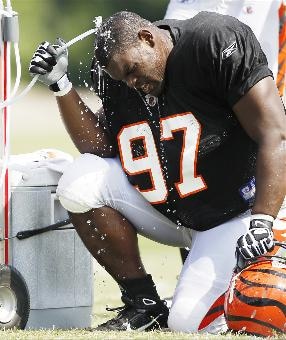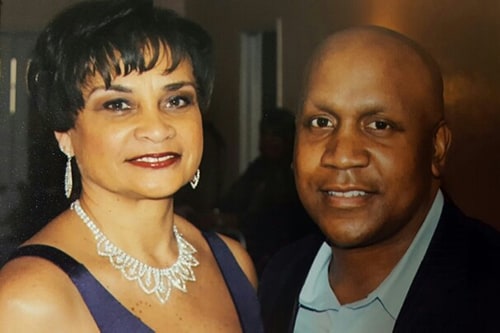
Real Stories from People Living with Sickle Cell Disease
Mikeia Green’s Story

“I knew there were a lot of things I could do to help myself stay healthy. I didn’t want to end up in the hospital and miss class,” said Mikeia Green about her experience managing sickle cell disease (SCD) in college. She was born with SCD, which is an inherited blood disease, which means it can run in families. SCD causes abnormal, “sickle” shaped red blood cells that stick together and block blood flow in the body, limiting the amount of oxygen reaching the body’s organs. People with SCD can have frequent pain (when it’s severe, it is called a pain crisis), infection, and other health problems. Today, Mikeia, 23, is a recent college graduate working at a psychiatric office in California.
Growing up, Mikeia’s mother took care of her so as to keep her healthy with SCD. She took Mikeia to every doctor’s appointment, created an emergency plan, and watched for Mikeia’s “triggers.” These “triggers,” such as stress, dehydration, and extreme temperatures, can lead to mild to severe pain crises. “She knew me very well. She paid attention to my triggers – managing stress, drinking enough water, and making sure I didn’t overexert myself.”
When Mikeia left her home in Arizona to attend college in California, it was the first time she was away from her mother. “That’s when I had to learn how to speak up for myself and learn how to make appointments by myself. I had to schedule doctor appointments between classes and figure out which friends I wanted to tell about my illness, in case something happened, and to whom I wanted to give my mom’s phone number if I didn’t feel good. I had to have a conversation about sickle cell with my residential advisor (RA), and I also had to reach out to the student wellness center because they offer certain services for students with disabilities.”
Mikeia reached out to the Sickle Cell Disease Foundation in California (SCDFC) for support and resources to help her find a doctor. She also connected with a social worker from the Children’s Hospital of Los Angeles to help her transition from her previous pediatric care to an adult care specialist.
While in college, Mikeia never let her SCD condition limit what she could accomplish. She was involved in a variety of service and cultural organizations, tutored students, held a work-study job, and made time for the gym to stay healthy. “I had to learn how to be responsible in terms of my education and learn how to be responsible for my health.”
During Mikeia’s four years in college, she sometimes experienced pain, but the only episode of a severe pain crisis happened during her freshman year. Fortunately, Mikeia did not have to visit the emergency department. She talked to her RA and sought help to manage the episode in her dorm room.
Mikeia recommends that students with SCD find what services are available to them on campus. “There are always some type of wellness or disability resources available,” said Mikeia. She got a single-occupancy room for four years, was able to choose her classes early, and was given opportunities to make up exams she missed when pain or other health problems made it difficult to concentrate. These accommodations helped her to manage her condition while being a typical college student.
When asked to share advice for students with SCD, Mikeia said, “Don’t ever look at your disease as a hindrance. You are more than capable of going to college and being successful. You just have to know yourself and pay attention to your health because you won’t be able to do that unless you’re at your best – health-wise.”
For more information on SCD, visit www.cdc.gov/ncbddd/sicklecell.
CDC would like to thank Mikeia for sharing her story.
The Johnson Family’s Story
“When you lose your child, it’s real. It’s been 5 years for me. People will tell you time will heal, but it doesn’t really heal. You just learn how to cope,” said Ritchie Johnson on the loss of her son, Chris, to a rare kidney cancer linked to sickle cell trait (SCT).
Chris was born with SCT, a genetic condition that occurs when a child inherits one sickle cell gene and one normal gene from the parents. When two sickle cell genes are inherited, the child is born with sickle cell disease (SCD), which can cause pain, acute chest syndrome, stroke, and other serious health problems. SCT is often seen as a less dangerous condition compared to SCD because people with SCT often do not experience the painful and life-threatening symptoms of SCD.
After a newborn screening revealed Chris had SCT, the hospital provided little information on the condition. “I was told that SCT was nothing to worry about and that you could live a long, normal, and healthy life without any problems,” said Ritchie.
Chris had an active childhood and played sports. He earned a football scholarship from the University of New Mexico. SCT never limited his lifestyle.
At the age of 38, Chris saw blood in his urine. At the emergency room, a CT scan found a tumor in his right kidney. Chris was diagnosed with an extremely rare form of kidney cancer known as renal medullary carcinoma (RMC). Common symptoms of kidney cancer include pain in the lower back, blood in the urine, and weight loss.
RMC has been linked to SCT. RMC is aggressive and typically leads to death. It’s especially difficult to treat because of limited awareness and research on the disease. There is no medicine available for RMC. At the time of Chris’ diagnosis in 2011, there were no clinical trials (research studies that explore whether a medical strategy, treatment, or device is safe and effective for humans).
Chris and Ritchie were shocked. Before the diagnosis, Chris had lower back pain that continued for several years. He visited a primary care physician, a chiropractor (a doctor who specializes in diagnosing and treating disorders of the musculoskeletal and nervous system, especially in the spine), and even received physical therapy for the pain, but it never went away. Chris thought the pain was a football-related injury received in college or from a previous car crash. He never expected the pain to be a symptom of a kidney cancer linked to SCT. Even his healthcare providers never considered his pain to be linked to SCT or kidney cancer.
By the time Chris was diagnosed, the cancer was stage 4. Chris needed medical treatment immediately.
At the hospital, Chris was treated with chemotherapy and additional cancer treatments often used to treat other types of kidney cancer. Treatment was expensive, and at one point, hospital bills reached more than half a million dollars. Chris fought the cancer for one year until his body became de-sensitized to the treatments and rejected chemotherapy. “The cancer went through his body like wildfire,” said Ritchie. Chris passed away 3 months later in the fall of 2012.
In honor of Chris, Ritchie founded the Chris “CJ” Johnson Foundation in 2013. While Chris received treatment, he understood the need for awareness and information on kidney cancers, especially RMC and its link to SCT. The Foundation raises awareness and donates funds to advance RMC research, and it provides education and support to families battling RMC. Some progress has been made, including two clinical trials on RMC that help to better understand the condition. However, more awareness is needed.
“We’re working with pediatricians in the Houston area to have them look out for certain symptoms when a child is diagnosed with SCT. We’re not trying to scare anyone, but we want people to be aware of any possible symptoms that might be associated with RMC. Awareness is extremely important. We need to get the word out about RMC, and not just in the United States, because we have patients all over. We need to get this information out globally so that we can make a difference, and one day, hopefully, find a cure for RMC,” said Ritchie.
Although the pain of losing a child never goes away, Ritchie finds peace by helping others understand and cope with a devastating diagnosis. “The main thing is staying positive and not giving up. Even though my son was 39 years old when he passed, it’s still scary. People can reach out to us (the Foundation) for emotional support or whatever they need. They need someone to talk to during this time. Think positively and don’t give up. Stand strong and fight it,” said Ritchie.
Learn more about RMC and the Chris “CJ” Johnson Foundation here.
Learn more about kidney cancer here.
Find more information and resources on SCD and SCT here.
CDC would like to thank Ritchie Johnson for sharing her story.
Courtney Stinnett’s Story
Living with sickle cell can be challenging and unpredictable, but I believe it makes us some of the strongest people on earth.
The type of sickle cell disease (SCD) that I have is called hemoglobin S/beta(+)-thalassemia (also called sickle beta-thalassemia or HbS beta-thalassemia). Although it is a milder type of SCD, I still have pain episodes and other health issues. When I have a pain crisis, it can occur at any moment. It’s unpredictable. I can literally just start hurting all of a sudden. The only way I can describe a pain crisis is to compare it to a migraine headache, but it’s 10 times worse and located in the joints. I have gotten up in the morning feeling fine, driven to work, and could not get out of the car because of a pain crisis. The pain can be that sudden. I try to do things to avoid going into a crisis, but I cannot always prevent it from happening.
Certain things can help manage pain crises, such as staying hydrated, staying warm in the winter, staying cool in the summer, trying to avoid colds and infections by getting flu and pneumonia shots every year, and of course, taking my medicines and listening to my doctors.
It can be very frustrating to have a pain crisis, go to the emergency department, and not be believed or treated as a priority because I am not ‘behaving’ like I am in pain. My biggest fear is having a stroke.
My son has beta-thalassemia intermedia, also known as Cooley’s anemia. In Cooley’s anemia, the red blood cells have too little of the hemoglobin protein to adequately transport oxygen throughout the body, and the red blood cells don’t live as long. He does not experience pain crises, but he does need regular blood transfusions. Since the age of 4, he has been transfused every 5 to 8 weeks. Signs and symptoms related to Cooley’s anemia include fatigue, headache, difficulty concentrating, reduced ability to exercise, and slow physical growth. He is short, looks young for his age, and he has an individualized education program at school. He has had a splenectomy (a surgical procedure to remove the spleen), which means he has a greater risk of infection, so he takes penicillin every day. Believe it or not, it is easier for him to tell his friends that he has sickle cell rather than trying to explain his disease.
The transfusions can be overwhelming at times. Before each transfusion, there has to be a type and crossmatch done (two blood tests to determine whether blood from the donor is compatible with the person receiving the blood). The type and crossmatch is good for only 72 hours. If the transfusion has not begun within the 72 hour window, then another type and crossmatch needs to be done before he can receive blood. The amount of time between transfusions varies. As of now, the doctors have determined that my son needs a transfusion every 5 weeks. Regular transfusions can cause a dangerous buildup of iron in the body so he needs chelation therapy (medicine to lower the amount of iron in the body). He now takes five different medicines every day for his condition.
Between the two of us, keeping up with prescription refills and doctors’ appointments can be a part-time job. There have been times when I have had an appointment in the morning, only to return later in the evening or the next day for his appointment and vice-versa. Getting and/or keeping a job or maintaining school work can be difficult.
Thanks to certain medicines, such as hydroxyurea (a medicine that can reduce sickle cell-related health problems), people with SCD are able to live longer, healthier lives.
CDC would like to thank Courtney Stinnett for sharing her personal story.
The Green Family Story
“When AJ was born in 1992, there was a real lack of information and education about newborn screening and sickle cell disease. They just told us he was having a PKU shot and then the doctor actually called on the telephone and gave us his results. It wasn’t really something back then that they talked about. They just said that he has to have a PKU shot. We didn’t know then that it was newborn screening. The doctor told us that the newborn screening showed that AJ has sickle cell disease. I have the sickle cell trait and my husband has the trait. I didn’t really know anything about, or anybody with, the actual disease. But when the doctor said the word ‘disease’ I started crying because I knew that couldn’t be good. At that time, of course, I was devastated. I went to the computer and looked it up and saw what could happen to him and what was down the line for him.

“AJ had his first sickle cell crisis at about 8 months. We didn’t really know what to expect with a crisis, but the early newborn screening test was helpful because we knew he had sickle cell disease. When he had his first painful sickle cell crisis we would never have known to take him to the hospital. We probably would have just thought he was crying to be crying and put a bottle in his mouth. We knew something had to be wrong with him and we didn’t take it lightly. We took him to the hospital and they said that he was having a crisis in the top of his foot. It was important to have the newborn screening done so that we knew to watch for these things. If we hadn’t had the newborn screening done we wouldn’t have known what was going on with him and sought appropriate care right away.
“It’s important for parents to get newborn screening to know if there’s anything wrong with the child. If it’s sickle cell, it just makes you aware of what’s going on with the child, things to look for (if they’re dehydrated, not getting enough water, if they’re crying a lot from pain) because you don’t know that they’re hurting, they can’t tell you.” – Pam Green
AJ, at 19 years old, an accomplished singer and sickle cell disease advocate, has accomplished more than most teens his age and doesn’t let his condition keep him from reaching his goals. In addition to performing for two U.S. presidents, Clinton and Obama, the Grammy-hopeful has shared the stage with Elton John, the Canadian Tenors, Jason Mraz, Rob Thomas, and sang a duet with Jennifer Hudson. He continues to be a strong advocate for the community in his efforts to “put sickle cell on the map” by raising awareness of the condition so that someday it will receive as much attention as other high profile disease states such as cancer. He recently spoke with the kids at the Sickle Cell Disease Association of Mobile, Alabama and joined up with Remington College’s “3 Lives” blood drive campaign which raises awareness for minority blood donors and encourages people to donate blood.
“For the most part I have been able to meet all my goals, but I always strive for bigger goals in life so everything’s not complete just yet. My first aspiration was to be known as a singer and also as an advocate for sickle cell disease. I try to be that inspiration, you know. It’s not as bad as people try to make it seem. I mean, it is, but it’s not. People don’t have to be afraid of it; they don’t have to be held down by it. Try to find triumph in the situation.” – AJ Green
CDC would like to thank AJ and Pam for sharing this personal story.
Geno Atkins’ Story

“My story started when a young man met a young lady on the campus of Florida A&M University. On their first date he asked the young woman if she carried the sickle cell trait! That young man became my dad and the young lady is my mother. My dad carries the sickle cell trait and was well aware that if he married someone who also carries the trait, their kids had a 50% chance of being born with full blown sickle cell disease. He discovered that my mother is not a carrier of the sickle cell trait. The rest is history.
“I am the oldest of three children and the only one with sickle cell trait. The first time I learned I carry the sickle cell trait was as a freshman at the University of Georgia. I called home and my mother said, “Your dad has the trait, but I don’t recall the doctor saying you had the trait when you were born.” All newborns are tested for the trait in Florida, yet I had gone my whole life without knowing.
“Once I learned I had the trait I researched as much as I could and talked with the football training staff. They assured me that the trait would not affect my ability to play. There were four freshmen who tested positive for the trait along with me and we were assigned a trainer who watched us closely during practice sessions and on game day. I was not treated differently by my teammates and went about my life just as I had before. One day I learned that a football player had died from complications of sickle cell trait while participating in spring practice at another university. That’s when I realized that this is a serious issue and I should not take any chances with my health. I played at the highest level in college and it earned me a spot in the NFL.
“I knew from my research that it would not be good for me to play in high altitude, so I prayed I wouldn’t get drafted by Denver, which is at a high altitude. I ended up in Cincinnati and have played at a very high level without any adverse affects of the sickle cell trait. During the 2011 season we did travel to Denver to play the Broncos and that was the first time I can truly say I felt the effects of the trait. I could not breathe after a 10-play series and had to be given oxygen on the sideline.
“Some of the changes I’ve made in my life include eating healthy, avoiding drugs and alcohol, not smoking, and most importantly getting a lot of rest. Everyone in my family knows that I have to take my daily nap. I drink more water, sports drinks, and coconut water than ever before because it is important to stay well hydrated before and after activities.
“Having the sickle cell trait does not exclude an athlete from participating in sports, however, the training staff and coaches need to take precautions to ensure the athlete is not put in dangerous situations. In high school my coaches would get on me because I was always in the back during running drills and I often got very tired. I think back now and realize that it could have been a dangerous situation for me if over-zealous coaches or I had pushed too much during those hot days in south Florida.
“Each year I am saddened to learn of another young athlete dying from complications of the trait while participating in sports. This vicious cycle lets me know that not enough information, education, and spotlight are given to this issue. My goal is to start a foundation, with the primary focus on offering testing for athletes at the high school level and getting education for trainers and coaches on how to help the athletes be the best they can be.”
CDC would like to thank Geno Atkins for sharing his personal story.
If you would like to share your personal story, please contact us at Contact CDC-INFO























.png)









No hay comentarios:
Publicar un comentario